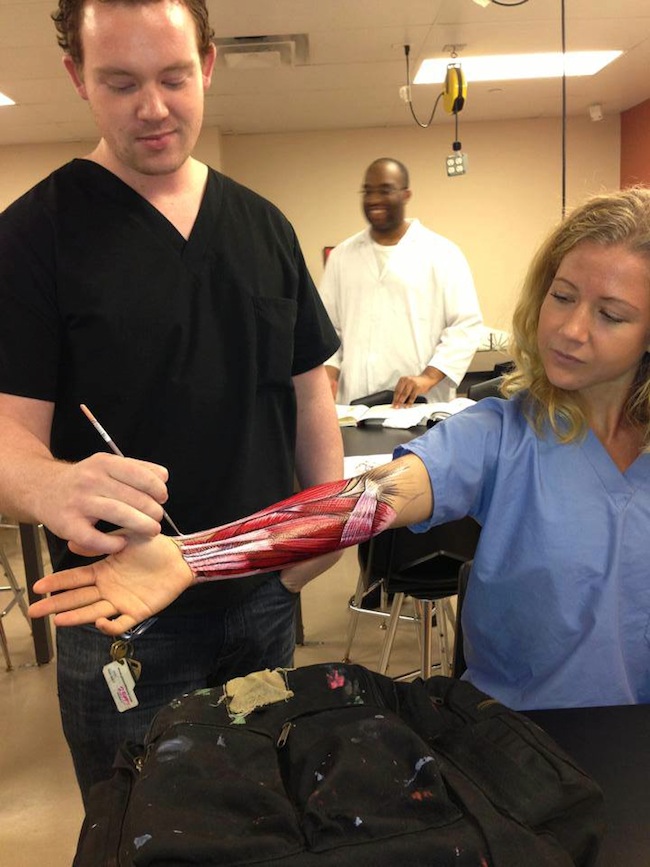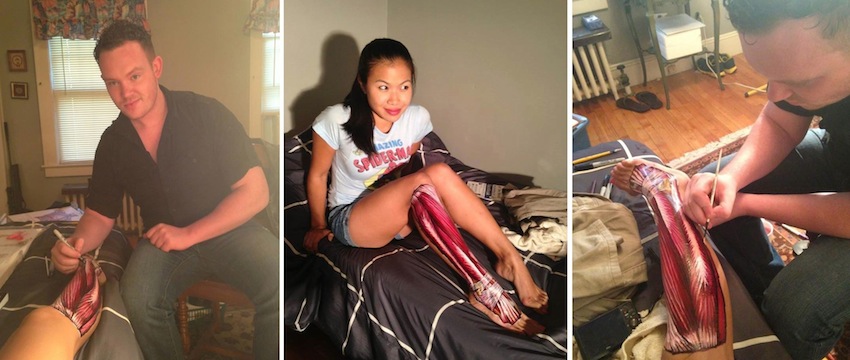Danny Quirk Is Changing The Way Anatomy Is Taught In Some Schools

Photos via Danny Quirk on Facebook
Springfield artist Danny Quirk was once perceived as “the weirdo that paints human anatomy,” but now he’s hailed as a go-to guest speaker in college labs and at medical conferences along the East Coast.
“This past year has been pretty intense,” said Quirk, referencing requests he’s fielded from professors who want him to appear in the classroom and share his extremely detailed—and anatomically correct—paintings of human muscles and tissue. “There has been a lot of interest. [I have become] the person being called for all these questions about anatomy [art]. It’s been an amazing transformation.”
Quirk uses latex and acrylics, spending up to 10 hours at a time on certain pieces, to create replicas of the muscles beneath peoples’ skin, allowing it to move as though it were really exposed.
The idea started a few years ago, after creating a series of watercolor paintings he called “self-dissection.” A girlfriend at the time asked Quirk to paint her like a zombie for Halloween. That make-up session turned into Quirk creating an accurate portrayal of human muscles on her skin, and later posting a photo of it online, which quickly went viral.
“I immediately thought, ‘I should do some more of these,’” said Quirk.
So he did.
Now, Quirk, a graduate of Pratt Institute in New York, has been using contacts he made during and after college to showcase his talent.
The online success has given him the opportunity to paint models for New York Fashion Week, and the “Body Worlds” art exhibit, which uses real skinless human figures and puts them on display for public viewing.
It has also led to interest from medical professionals. As of now, plans are still coming together for speaking engagements at universities, but Quirk said he is in contact with teachers in Maine, New York, and even North Carolina.
Already, he appeared before an anatomy class at Dominican College in Orangeburg, New York, where he applied the intricate artwork onto students, in exchange for a free lesson in anatomy. A professor was originally going to pay Quirk for a series of paintings to use as examples in her class, but he bartered to take the course instead.
“As of right now, I have some made some pretty decent friends in the field who have allowed to trade work for education,” he said. “With that particular professor, if they were dissecting the back or forearm for the class, it can be difficult to grasp how it works, because there are a ton of muscles. So I ended up painting the anatomy on the students, and they could see how it works and how it moves in real life. It develops a pretty strong understanding of how the body works. It has proven to be beneficial to the students.”
In July, he’ll step away from the lab and will be a featured guest speaker at the Association of Medical Illustrators Conference, an annual gathering of top artists and researchers that strive to further the use of visual media to advance life sciences, medicine, and healthcare in the industry.
Quirk is still adjusting to the opportunities that have been presented to him, thanks to the internet.
“The guys and girls involved in that institution are phenomenal. The mere fact I will be speaking there is so exciting,” said Quirk. “It’s one of those things, and I hate to say it aloud, but I have learned that the whole education thing—you can totally learn it on your own and you don’t have to fall victim to going to school for all these years. We live in this age of information, where so many things are available to us.”




